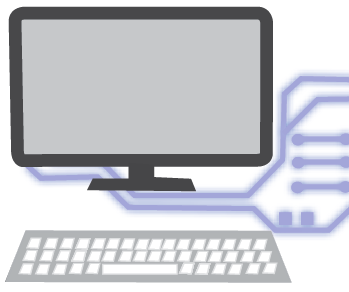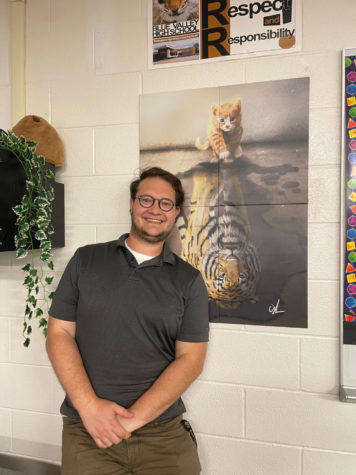Enhancing Learning Capacities
A mixture of digital, traditional learning styles provides high-quality education for all students

Even before the beginning of the Covid-19 pandemic, education in the Blue Valley School District saw a shift to digital learning. Throughout 2020, students experienced total online or hybrid learning. It wasn’t until the 2021-2022 school year that students were able to return fully in-person to school and learn like they had prior to the pandemic, with more paper and pencil assignments.
This constant switching back and forth between digital and traditional learning has sparked debate within schools about which is better or worse for students. Some prefer to take notes by hand and have all of their assignments be on paper, while others would rather do all of their work through Canvas and Google Drive.
There is a wide range of opinions on the subject, but many of them boil down to how staring at a screen for long periods of time can affect students’ physical and mental health, and whether the benefits of either method outweigh the negatives.
Controversy with Technology
Due to the pandemic, education at Blue Valley — and education in general — saw a notable shift to online, digitized learning. For students’ academic lives, technology provides access to online information and resources, and the establishment of digital learning environments has evident positive and negative aspects.
A common assertion of the positives is that, with the introduction to digital schooling, students will improve their future career skills, namely online communication and collaboration.
According to web development company Go1, digital learning is “creating a smarter, more productive civilization, but also one that is well-informed about new technologies and able to stay on top of emerging trends.”
Technology has an ever-growing presence in society, so it was only a matter of time until it spread through general education. Many pro-digital learning advocates argue that exposing students to technology through their education will motivate them to learn because, in this generation, students are already comfortable with technology. Alternative methods of education can be used to show students who otherwise struggle in a traditional classroom that there are different ways to learn, rather than the “one size fits all” method.
Contrarily, technology in learning can lead to adverse effects, such as a decline in student-teacher connections, excessive screen time and negative cognitive development. Too much technology exposure can affect children’s cognitive process and their developing sense of reality.
As mentioned in an article from e-student.org, online and tech-centered learning can cause social isolation and limited feedback opportunities and is “inaccessible to the computer illiterate population.” Digitized learning has proven to be highly effective in the classroom and improves academic performance; however, technology also opens an easy gateway for cheating.
Another concern of the shift to digital learning is that not all areas of study can be effectively digitized. This shift to digital learning has proven to be a controversial subject, with many arguing that technological education is the future and others arguing that it will be the downfall of productive traditional learning practices.
Digital Debate
Over the last two decades, digital technology has rapidly expanded to influence nearly every part of life. Schoolwork, for Blue Valley and various other educational institutions, is no exception to this growth. Junior Mattie Thornton and senior Phoenix Smith both have first-hand experiences with this trend.
“Teachers have put most assignments on computers,” Thornton said. “We have to pay attention to due dates [online] a lot more.”
Though digital deadlines appear to be rising in popularity, Smith noted there is a newfound balance of learning methods at BV.
“Last year, it was like we just showed up to class and did online school,” she said. “This year, I feel like they’re integrating a lot more like paper assignments and discussions in class.”
Along with changing the logistics of specific assignments, digital learning prompted many teachers to pursue a “flipped classroom” structure. This approach is characterized by the learning of subject matter outside of school and the completion of homework while in class. Though it may benefit some, the teaching style is not for everyone.
“I don’t like reverse classes,” Thornton said. “They confuse me, and I like being with the teacher when the material is being taught instead of at home.”
Even when flipped classrooms are not implemented, digital schoolwork offers a unique set of challenges for certain students.
“My eyes hurt after being on my computer for a long time,” Thornton said. “[On the computer], I’m going to get distracted. I can go into different tabs and start online shopping, and nobody’s going to know. There’s no one keeping me accountable other than myself, and I’m not good at that.”

While Thornton holds a less favorable view of digital learning, Smith outlines a key benefit.
“Doing stuff online helps me a lot because I struggle with organization,” Smith said. “When the assignments are online, they get put into Canvas automatically, and I can just look at the to-do list. Also, I can’t lose a physical paper when it’s in my Google Drive.”
At the heart of many digital education debates is its efficacy in getting students to absorb material. For Thornton, computers don’t usually suffice.
“I would rather do it on paper,” Thornton said. “I like writing 100% [more than typing]. Writing it down just goes in my brain better instead of pushing buttons.”
Though computerized learning struggles to compete against traditional methods in some aspects, its efficiency is a compelling argument for its use.
“In schools where technology is already implemented, it can be a lot cheaper for them to have assignments online because they already have the resources they need and they’re very reusable,” Smith said. “For teachers who know how to use the technology, it can be a lot easier because they’re able to put most of their assignments in the same format.”

All things considered, both Smith and Thornton deem the rise of digital learning to be primarily beneficial and cite organization as a major factor.
“For me, it’s definitely a positive shift,” Smith said. “It’s just easier to have everything in one place, but I know for a lot of people it is more difficult because they have trouble focusing when everything’s on a screen.”
Smith and Thornton agreed the current mix of online and traditional methods is the best option moving forward.
“[Blended learning] should be kept how it is this year because there’s a balance, and it’s something that works better for some people than others,” Smith said. “Everybody’s able to get classes that are what they need.”
Flipping the Norms
Although digitized learning has been on the back burner for years, the pandemic recently pushed it into the spotlight. Caden Laptad, a teacher of three math classes, is one of many at BV who has turned his classroom into a digitalized learning environment.
“Students have the potential to achieve greater success in a flipped classroom,” Laptad said. “Once they see a teacher use digitalized learning effectively, it’s pretty hard to want to go back.”
Altering the way lessons are being taught in the classroom has come with many benefits.
“Digital learning allows us to break instruction out into strategically designed videos [that let] students move at their own pace,” he said. “For example, in a normal live lesson, one student might have a very pertinent question but the other students could already have knowledge of or are not interested in the answer. This would add time to the lesson and become a distraction from the focus of the learning process.”
Grading, which typically consumes an enormous amount of time during the week, has also become a much faster process.
“Students can sometimes forget that if we have given a test in our classes, we might have 60 of those to score,” Laptad said. “If there are 20 problems on a test given to 60 students, that’s 1,200 problems we have to grade. This, [unfortunately], results in time lost in the evenings that we can’t spend planning or reacting to student feedback.”
Despite the advantages of turning to electronics, there are certain things that work better on paper. Even with a preference for the digitalization of education, Laptad said a blended format works best for his classroom.
“Paper tests and quizzes are often the best way I can know how my students are learning,” he said. “I can see their work, the way they’re thinking and the places they’re likely to make mistakes.”
Furthermore, digital learning can be harder than traditional classrooms, as it can only work if the instructor applies it practically.
“Providing a 30- to 40-minute video to watch every night and then expecting students to do homework without any help isn’t very effective instruction,” he said. “But if students have videos that are 15 to 20 minutes and only focus on the core essential pieces, they’re more willing to get information. [I’ve found that] they tend to be more focused, attentive and thinking more critically during bell ringers or daily practice assignments.”
Flipped learning also puts responsibility and self-discipline on the student’s shoulders, as negligence can cause them to get less learning out of the process.
“The advantage of having flipped videos can only be realized if students ask good questions when they have time to work with one another and with the instructor. As long as they’re asking questions, navigating through difficult problems and really seeking the learning provided, being flipped is just as much hands-on as long as they’re in the right environment,” Laptad said. “If they don’t do these, students can get into some bad habits in their learning.”
In spite of the work that goes into a flipped classroom, Laptad believes it provides an opportunity for students to learn better than they would in a conventional learning environment.
“This is a really important conversation that I hope more teachers are thinking about,” Laptad said. “Digitalization is the power of individualization.”
Integrating Technology
For many students within our school, technical difficulties have always been a problem; but for Technology Information Specialist Keil Pittman, he knows they will always be a part of life and the only way to help students grow in their learning is by embracing how little or how much technology will be a part of the school’s environment.
While some students prefer learning physically with paper and pencil, today’s environment has slowly gone online over the past 10 years.

“I’m not a fan of increasing screen time for anyone, but the world is moving in a digital way,” Pittman said. “The more heads’ up we can give our students, the better off they’re going to be in the real world.”
Because of the way things have evolved over the past years, U.S History teacher Tony Scardino noticed the little effects of going online.
“The negative is not being able to connect with your kids in any way, shape or form — even when we were in hybrid, you had half of the kids here, yet they’re in masks,” Scardino said. “That was something that separated us [and] it was interesting because you start to have kids coming up with headaches and eye problems and I never would have foreseen that.”

Even with the disadvantages of online learning, Pittman has an idea that will help the environment and also students.
“I would love to empower our math and science, not just teachers, but students with the ability of digital writing, to actually put a digital pen to an iPad, so they can work through formulas,” he said. “In my position, when I first came in to look at the amount of paper that we were using and how much that was costing us, it’s a reasonable jump to go digital [to save] funds that could be used for other things. Not that the paper was killing us, but we were budgeting a certain amount and [using] twice as much.”
Along with Pittman, Scardino knows the positives and negatives of technology, but he also prefers to use less of it in his classroom.
“I don’t like reading with a Kindle or anything like that. I want my book — I’m just old-fashioned. I like the tactile thing of holding a book and I think that there are lots of kids that are that way,” Scardino said. “In social studies, in particular, we’ve tried hard to do the things that are going to help you when you move on and go to college because you’re going to have to write. We’ve changed from being totally content-driven to focus more on 21st-century skills.”

Isaac Hudson is a senior and one of the editors-in-chief this year. It is his fourth year on staff. He is also the president of BV’s Latin Club, and...

Ella Lim is a senior and it is her third year on staff! She is one of the editors-in-chief this year and spent the previous year as a web editor. She is...

Ava McGuire is the Editor-in-Chief for The Tiger Print. This is her senior year and her third year on staff. Fun fact: Ava has lived in many places throughout...

Andrew Sharber is a senior and this is his third year on staff. He has been in the band since middle school and enjoys traveling with both the marching...

Rhylan Stern is a senior and it is her third year on staff. While being one of the editors-in-chief, she is a member of Tiger’s Inc. Strategic Marketing...

Charley Thomas is a senior and serves as Editor-in-Chief of the Tiger Print this year. At BV, she is a member of the Varsity Volleyball Team, Student Council,...





